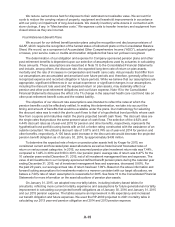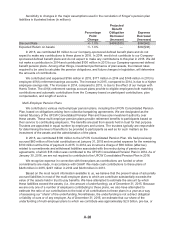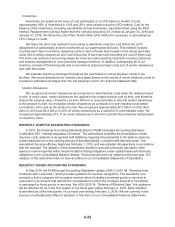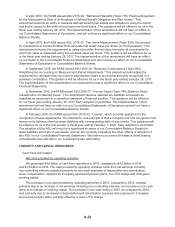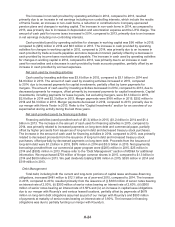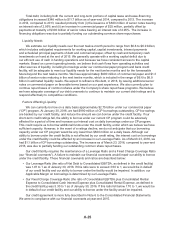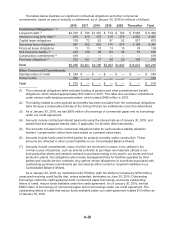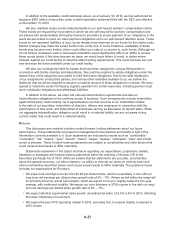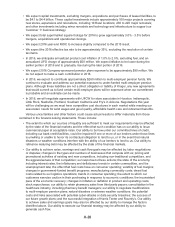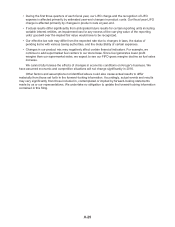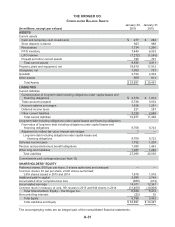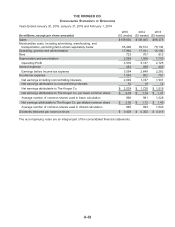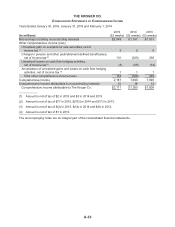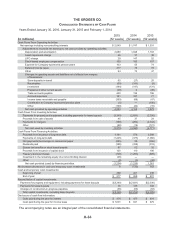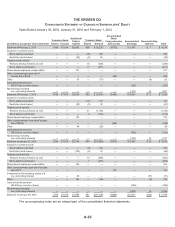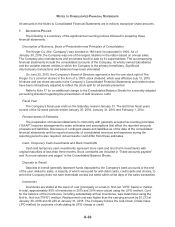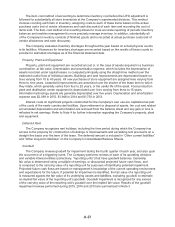Kroger 2015 Annual Report Download - page 102
Download and view the complete annual report
Please find page 102 of the 2015 Kroger annual report below. You can navigate through the pages in the report by either clicking on the pages listed below, or by using the keyword search tool below to find specific information within the annual report.A-28
• We expect capital investments, excluding mergers, acquisitions and purchases of leased facilities, to
be $4.1 to $4.4 billion. These capital investments include approximately 100 major projects covering
new stores, expansions and relocations, including 10 Ruler locations; 200 to 220 major remodels;
and other investments including minor remodels and technology and infrastructure to support our
Customer 1st business strategy.
• We expect total supermarket square footage for 2016 to grow approximately 3.0% - 3.5% before
mergers, acquisitions and operational closings.
• We expect 2016 year-end ROIC to increase slightly compared to the 2015 result.
• We expect the 2016 effective tax rate to be approximately 35%, excluding the resolution of certain
tax items.
• In 2016, we anticipate annualized product cost inflation of 1.0% to 2.0%, excluding fuel, and an
annualized LIFO charge of approximately $50 million. We expect inflation to be lower during the
earlier portion of 2016 and to gradually rise during the later portion of 2016.
• We expect 2016 Company-sponsored pension plans expense to be approximately $80 million. We
do not expect to make a cash contribution in 2016.
• In 2016, we expect to contribute approximately $260 million to multi-employer pension funds. We
continue to evaluate and address our potential exposure to under-funded multi-employer pension
plans. Although these liabilities are not a direct obligation or liability of Kroger, any new agreements
that would commit us to fund certain multi-employer plans will be expensed when our commitment
is probable and an estimate can be made.
• In 2016, we will negotiate agreements with UFCW for store associates in Houston, Indianapolis,
Little Rock, Nashville, Portland, Southern California and Fry’s in Arizona. Negotiations this year
will be challenging as we must have competitive cost structures in each market while meeting our
associates’ needs for solid wages and good quality, affordable health care and retirement benefits.
Various uncertainties and other factors could cause actual results to differ materially from those
contained in the forward-looking statements. These include:
• The extent to which our sources of liquidity are sufficient to meet our requirements may be affected
by the state of the financial markets and the effect that such condition has on our ability to issue
commercial paper at acceptable rates. Our ability to borrow under our committed lines of credit,
including our bank credit facilities, could be impaired if one or more of our lenders under those lines
is unwilling or unable to honor its contractual obligation to lend to us, or in the event that natural
disasters or weather conditions interfere with the ability of our lenders to lend to us. Our ability to
refinance maturing debt may be affected by the state of the financial markets.
• Our ability to achieve sales, earnings and cash flow goals may be affected by: labor negotiations
or disputes; changes in the types and numbers of businesses that compete with us; pricing and
promotional activities of existing and new competitors, including non-traditional competitors, and
the aggressiveness of that competition; our response to these actions; the state of the economy,
including interest rates, the inflationary and deflationary trends in certain commodities, and the
unemployment rate; the effect that fuel costs have on consumer spending; volatility of fuel margins;
changes in government-funded benefit programs; manufacturing commodity costs; diesel fuel
costs related to our logistics operations; trends in consumer spending; the extent to which our
customers exercise caution in their purchasing in response to economic conditions; the inconsistent
pace of the economic recovery; changes in inflation or deflation in product and operating costs;
stock repurchases; our ability to retain pharmacy sales from third party payors; consolidation in the
healthcare industry, including pharmacy benefit managers; our ability to negotiate modifications
to multi-employer pension plans; natural disasters or adverse weather conditions; the potential
costs and risks associated with potential cyber-attacks or data security breaches; the success of
our future growth plans; and the successful integration of Harris Teeter and Roundy’s. Our ability
to achieve sales and earnings goals may also be affected by our ability to manage the factors
identified above. Our ability to execute our financial strategy may be affected by our ability to
generate cash flow.



